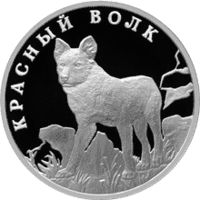Dhole
| Dhole Temporal range:Middle Pleistocene– Recent
| |
|---|---|

| |
| Scientific classification | |
| Domain: | Eukaryota |
| Kingdom: | Animalia |
| Phylum: | Chordata |
| Class: | Mammalia |
| Order: | Carnivora |
| Family: | Canidae |
| Subfamily: | Caninae |
| Tribe: | Canini |
| Genus: | Cuon Hodgson,1838 |
| Species: | C. alpinus
|
| Binomial name | |
| Cuon alpinus (Pallas,1811)
| |
| Subspecies | |
| |

| |
| dhole range | |
| Synonyms | |
|
Canis alpinus | |
Thedhole(/doʊl/dohl;[2][3]Cuon alpinus) is acanidnative toCentral,South,EastandSoutheast Asia.It is genetically close to species within thegenusCanis,[4]: Fig. 10 but distinct in several anatomical aspects: itsskullis convex rather than concave in profile, it lacks a third lowermolar[5]and the upper molars possess only a singlecuspas opposed to between two and four.[6]During thePleistocene,the dhole ranged throughoutAsia,with its range also extending intoEurope(with a single record also reported fromNorth America) but became restricted to its historical range 12,000–18,000 years ago.[7]
The dhole is a highly social animal, living in large clans without rigiddominance hierarchies[8]and containing multiple breeding females.[9]Such clans usually consist of about 12 individuals, but groups of over 40 are known.[10]It is a diurnal pack hunter which preferentially targets large and medium-sizedungulates.[11]In tropical forests, the dhole competes with thetiger(Panthera tigris) and theleopard(Panthera pardus), targeting somewhat different prey species, but still with substantial dietary overlap.[12]
It is listed asEndangeredon theIUCN Red List,as populations are decreasing and estimated to comprise fewer than 2,500 mature individuals. Factors contributing to this decline include habitat loss, loss of prey, competition with other species, persecution due to livestock predation, and disease transfer fromdomestic dogs.[1]
Etymology and naming[edit]
Theetymologyof "dhole" is unclear. The possible earliest written use of the word in English occurred in 1808 by soldier Thomas Williamson, who encountered the animal inRamghur district,India.He stated thatdholewas a common local name for the species.[13]In 1827,Charles Hamilton Smithclaimed that it was derived from a language spoken in 'various parts of the East'.[14]
Two years later, Smith connected this word withTurkish:deli'mad, crazy', and erroneously compared the Turkish word withOld Saxon:dolandDutch:dol(cfr. also English:dull;German:toll),[15]which are in fact from theProto-Germanic*dwalaz'foolish, stupid'.[16]Richard Lydekkerwrote nearly 80 years later that the word was not used by the natives living within the species' range.[17]TheMerriam-WebsterDictionarytheorises that it may have come from theKannada:ತೋಳ,romanized:tōḷa,lit. 'wolf'.[18]
Other English names for the species includeAsian wild dog,Asiatic wild dog,[19]Indian wild dog,[17]whistling dog,red dog,[10]red wolf,[6]andmountain wolf.[20]
Taxonomy and evolution[edit]
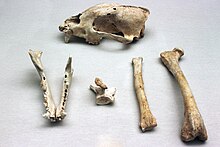
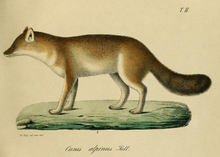
Canis alpinuswas thebinomial nameproposed byPeter Simon Pallasin 1811, who described its range as encompassing the upper levels of Udskoi Ostrog inAmurland,towards the eastern side and in the region of the upperLena River,around theYeniseiRiver and occasionally crossing intoChina.[22][23]This northern Russian range reported by Pallas during the 18th and 19th centuries is "considerably north" of where this species occurs today.[23]
Canis primaevuswas a name proposed byBrian Houghton Hodgsonin 1833 who thought that the dhole was a primitiveCanisform and theprogenitorof thedomestic dog.[24]Hodgson later took note of the dhole's physical distinctiveness from the genusCanisand proposed the genusCuon.[25]
The first study on the origins of the species was conducted by paleontologist Erich Thenius, who concluded in 1955 that the dhole was a post-Pleistocene descendant of a golden jackal-like ancestor.[26]The paleontologistBjorn Kurtenwrote in his 1968 bookPleistocene Mammals of Europethat the primitive dholeCanis majoriDel Campana 1913 —the remains of which have been found inVillafranchianeraValdarno,Italy and in China—was almost indistinguishable from the genusCanis.In comparison, the modern species has greatly reducedmolarsand thecuspshave developed into sharply trenchant points. During the EarlyMiddle Pleistocenethere arose bothCanis majori stehlinithat was the size of a largewolf,and the early dholeCanis alpinusPallas 1811 which first appeared atHundsheimandMosbachin Germany. In theLate Pleistoceneera theEuropean dhole(C. a. europaeus) was modern-looking and the transformation of the lower molar into a single cusped, slicing tooth had been completed; however, its size was comparable with that of a wolf. This subspecies became extinct in Europe at the end of the lateWürmperiod, but the species as a whole still inhabits a large area of Asia.[27]The European dhole may have survived up until the earlyHolocenein theIberian Peninsula.[28]and what is believed to be dhole remains have been found at Riparo Fredian in northernItalydated 10,800 years old.[29][30]
The vast Pleistocene range of this species also included numerous islands in Asia that this species no longer inhabits, such asSri Lanka,Borneoand possiblyPalawanin thePhilippines.[31][32][33][34][35][36]Middle Pleistocene dhole fossils have also been found in the Matsukae Cave in northernKyushuIsland in westernJapanand in the Lower Kuzuu fauna inTochigi PrefectureinHonshuIsland, east Japan.[37]Dhole fossils from the Late Pleistocene dated to about 10,700 years before present are known from theLuobi Caveor Luobi-Dong cave inHainan Islandinsouth Chinawhere they no longer exist.[38]Additionally, fossils of canidae possibly belonging to dhole have been excavated fromDajia RiverinTaichung County,Taiwan.[39]
A single record of the dhole is known from North America. This consists of a jaw fragment and teeth ofLate Pleistoceneage found in San Josecito Cave in northeast Mexico, dating to around 27-11,000 years ago.[40]
| Phylogenetic treeof thewolf-like canidswith timing in millions of years[a] |
Dholes are also known from the Middle and Late Pleistocene fossil record of Europe.[41]In 2021, the analyses of themitochondrialgenomesextracted from the fossil remains of two extinct European dhole specimens from the Jáchymka cave,Czech Republicdated 35,000–45,000 years old indicate that these were geneticallybasalto modern dholes and possessed much greater genetic diversity.[30]
The dhole's distinctive morphology has been a source of much confusion in determining the species' systematic position among the Canidae.George Simpsonplaced the dhole in thesubfamilySimocyoninae alongside theAfrican wild dogand thebush dog,on account of all three species' similar dentition.[42]Subsequent authors, includingJuliet Clutton-Brock,noted greater morphological similarities to canids of the generaCanis,DusicyonandAlopexthan to eitherSpeothosorLycaon,with any resemblance to the latter two being due toconvergent evolution.[5]
Some authors consider the extinctCanissubgenusXenocyonas ancestral to both the genusLycaonand the genusCuon.[43][44][45][46]: p149 Subsequent studies on the canidgenomerevealed that the dhole and African wild dog are closely related to members of the genusCanis.[4]This closeness toCanismay have been confirmed in a menagerie inMadras,where according to zoologistReginald Innes Pocockthere is a record of a dhole that interbred with a golden jackal.[47]DNA sequencing of theSardinian dhole(Cynotherium sardous) an extinct small canine species formerly native to the island of Sardinia in the Mediterranean, and which has often been suggested to have descended fromXenocyon,has found that it is most closely related to the living dhole among canines.[48]
Admixture with the African wild dog[edit]
In 2018,whole genome sequencingwas used to compare all members (apart from the black-backed and side-striped jackals) of the genusCanis,along with the dhole and theAfrican wild dog(Lycaon pictus). There was strong evidence of ancientgenetic admixturebetween the dhole and the African wild dog. Today, their ranges are remote from each other; however, during thePleistoceneera the dhole could be found as far west as Europe. The study proposes that the dhole's distribution may have once included theMiddle East,from where it may have admixed with the African wild dog inNorth Africa.However, there is no evidence of the dhole having existed in the Middle East nor North Africa,[49]though theLycaonwas present in Europe during the Early Pleistocene, with its last record in the region dating to 830,000 years ago. Genetic evidence from the Sardinan dhole suggests that both Sardinian and modern dholes share ancestry from theLycaeonlineage, but this ancestry is significantly higher in modern dholes than in the Sardinian dhole.[48]
Subspecies[edit]
Historically, up to ten subspecies of dholes have been recognised.[50]As of 2005[update],seven subspecies are recognised.[51][52]
However, studies on the dhole'smtDNAandmicrosatellitegenotype showed no clear subspecific distinctions. Nevertheless, two major phylogeographic groupings were discovered in dholes of the Asian mainland, which likely diverged during aglaciation event.One population extends from South, Central and North India (south of the Ganges) into Myanmar, and the other extends from India north of the Ganges into northeastern India, Myanmar, Thailand and the Malaysian Peninsula. The origin of dholes in Sumatra and Java is, as of 2005[update],unclear, as they show greater relatedness to dholes in India, Myanmar and China rather than with those in nearby Malaysia. However, theCanid Specialist Groupof theInternational Union for the Conservation of Nature(IUCN) states that further research is needed because all of the samples were from the southern part of this species' range and theTien Shansubspecies has distinct morphology.[53]
In the absence of further data, the researchers involved in the study speculated that Javan and Sumatran dholes could have been introduced to the islands by humans.[54]Fossils of dhole from the earlyMiddle Pleistocenehave been found inJava.[55]
| Subspecies | Image | Trinomial authority | Description | Distribution | Synonyms |
|---|---|---|---|---|---|
| C. a. adjustusBurmese dhole,[47]Indian dhole | 
|
Pocock, 1941[47] | Reddish coat, short hair on the paws and black whiskers[11] | Northeastern India and south of theGangesRiver, northern Myanmar[11] | antiquus(Matthew & Granger, 1923),dukhunensis(Sykes, 1831) |
| C. a. alpinusUssuri dhole[6] | 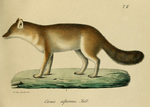
|
Pallas,1811[22] | Thick tawny red coat, greyish neck and ochre muzzle[11] | East of the easternSayan Mountains,eastern Russia, northeastern Asia[11] | –
|
| C. a. fumosus[56] | Pocock, 1936[56] | Luxuriant yellowish-red coat, dark back and grey neck[11] | WesternSichuan,China and Mongolia. Southern Myanmar, Thailand, Laos, Cambodia, Vietnam, Malaysia andJava,Indonesia[11] | infuscus(Pocock, 1936),javanicus(Desmarest, 1820) | |
| C. a. hesperiusTien Shan dhole[6] | 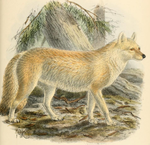
|
Afanasjev and Zolotarev, 1935[57] | Long yellow tinted coat, white underside and pale whiskers[11]Smaller thanC. a. alpinus,with wider skull and lighter-coloured winter fur.[6] | Eastern Russia and China[11] | jason(Pocock, 1936) |
| C. a. laniger[56] | Pocock, 1936[56] | Full, yellowish-grey coat, tail not black but same colour as body[11] | Southern Tibet, Himalayan Nepal, Sikkim, Bhutan and Kashmir[11] | grayiformis(Hodgson, 1863),primaevus(Hodgson, 1833) | |
| C. a. lepturus[56] | 
|
Heude, 1892[58] | Uniform red coat with thick underfur[11] | South of theYangtzeRiver, China[11] | clamitans(Heude, 1892),rutilans(Müller, 1839),sumatrensis(Hodgson, 1833) |
| Sumatran dhole and Javan dholeC. a. sumatrensis[59] | 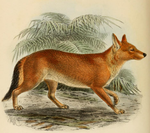
|
Hardwicke,1821[60] | Red coat and dark whiskers[11] | Sumatra,Indonesia[11]Its range is highly fragmented with multiple protected areas in Sumatra and Java.[1] |
Characteristics[edit]


The dhole's general tone of the fur is reddish, with the brightest hues occurring in winter. In the winter coat, the back is clothed in a saturated rusty-red to reddish colour with brownish highlights along the top of the head, neck and shoulders. The throat, chest, flanks, and belly and the upper parts of the limbs are less brightly coloured, and are more yellowish in tone. The lower parts of the limbs are whitish, with dark brownish bands on the anterior sides of the forelimbs. The muzzle and forehead are greyish-reddish. The tail is very luxuriant and fluffy, and is mainly of a reddish-ocherous colour, with a dark brown tip. The summer coat is shorter, coarser and darker.[6]The dorsal and lateralguard hairsin adults measure 20–30 mm (0.79–1.18 in) in length. Dholes in theMoscow Zoomoult once a year from March to May.[10]Amelanisticindividual was recorded in the northernCoimbatoreForest Division inTamil Nadu.[61]
The dhole has a wide and massive skull with a well-developedsagittal crest,[6]and itsmasseter musclesare highly developed compared to other canid species, giving the face an almosthyena-like appearance.[62]Therostrumis shorter than that of domestic dogs and most other canids.[10]It has six rather than seven lowermolars.[63] The upper molars are weak, being one third to one half the size of those of wolves and have only onecuspas opposed to between two and four, as is usual in canids,[6]an adaptation thought to improve shearing ability, thus allowing it to compete more successfully withkleptoparasites.[11] Adult females can weigh 10–17 kg (22–37 lb), while the slightly larger male may weigh 15–21 kg (33–46 lb). The mean weight of adults from three small samples was 15.1 kg (33 lb).[11][64]
In appearance, the dhole has been variously described as combining the physical characteristics of thegray wolfand thered fox,[6]and as being "cat-like" on account of its long backbone and slender limbs.[26]
Distribution and habitat[edit]
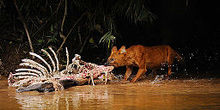
The dhole can be found inTibetand possibly also inNorth KoreaandPakistan.It once inhabited the alpine steppes extending intoKashmirto theLadakharea.[1] In Central Asia, the dhole primarily inhabits mountainous areas; in the western part of its range, it lives mostly in alpine meadows and high-montane steppes, while in the east, it mainly ranges in montanetaigas,and is sometimes sighted alongcoastlines.In India, Myanmar, Indochina, Indonesia and China, it prefers forested areas inalpine zonesand is occasionally sighted inplainsregions.[6]
In thePamir Mountainsof southernKyrgyzstan,the presence of the dhole was confirmed in 2019.[65]

The dhole might still be present in theTunkinsky National Parkin extreme southernSiberianearLake Baikal.[66]It possibly still lives in thePrimorsky Kraiprovince in far eastern Russia, where it was considered a rare and endangered species in 2004, with unconfirmed reports in the Pikthsa-Tigrovy Dom protected forest area; no sighting was reported in other areas since the late 1970s.[67][page needed] Currently, no other recent reports are confirmed of dhole being present inRussia.[68]However, the dhole might be present in the easternSayan Mountainsand in theTransbaikalregion; it has been sighted inTofalariain theIrkutsk Oblast,theRepublic of BuryatiaandZabaykalsky Krai.[68]
One pack was sighted in theQilian Mountainsin 2006.[69] In 2011 to 2013, local government officials and herders reported the presence of several dhole packs at elevations of 2,000 to 3,500 m (6,600 to 11,500 ft) nearTaxkorgan Nature Reservein theXin gian gAutonomous Region. Several packs and a female adult with pups were also recorded bycamera trapsat elevations of around 2,500 to 4,000 m (8,200 to 13,100 ft) in Yanchiwan National Nature Reserve in the northernGansu Provincein 2013–2014.[70] Dholes have been also reported in theAltyn-TaghMountains.[71]
In China'sYunnanProvince, dholes were recorded inBaima Xueshan Nature Reservein 2010–2011.[72]Dhole samples were obtained inJiangxiProvince in 2013.[73] Confirmed records by camera-trapping since 2008 have occurred in southern and westernGansuprovince, southernShaanxiprovince, southernQinghaiprovince, southern and westernYunnanprovince, westernSichuanprovince, the southernXin gian gAutonomous Region and in the SoutheasternTibetAutonomoous Region.[74]There are also historical records of dhole dating to 1521–1935 in Hainan Island, but the species is no longer present and is estimated to have become extinct around 1942.[38]
The dhole occurs in most of India south of the Ganges, particularly in the Central Indian Highlands and theWesternandEastern Ghats.It is also present inArunachal Pradesh,Assam,MeghalayaandWest Bengaland in theIndo-Gangetic Plain'sTerairegion. Dhole populations in theHimalayasand northwest India are fragmented.[1]
In 2011, dhole packs were recorded by camera traps in theChitwan National Park.[75]Its presence was confirmed in theKanchenjunga Conservation Areain 2011 by camera traps.[76]In February 2020, dholes were sighted in theVansda National Park,with camera traps confirming the presence of two individuals in May of the same year. This was the first confirmed sighting of dholes inGujaratsince 1970.[77]
InBhutan,the dhole is present inJigme Dorji National Park.[78][79]
InBangladesh,it inhabits forest reserves in theSylhetarea, as well theChittagong Hill Tractsin the southeast. Recent camera trap photos in the Chittagong in 2016 showed the continued presence of the dhole.[80]These regions probably do not harbour a viable population, as mostly small groups or solitary individuals were sighted.[1]
InMyanmar,the dhole is present in several protected areas.[1]In 2015, dholes and tigers were recorded by camera-traps for the first time in the hill forests ofKaren State.[81]
Its range is highly fragmented in theMalaysian Peninsula,Sumatra,Java,VietnamandThailand.[1]In 2014, camera trap videos in the montane tropical forests at 2,000 m (6,600 ft) in theKerinci Seblat National Parkin Sumatra revealed its continued presence.[82]A camera trapping survey in theKhao Ang Rue Nai Wildlife Sanctuaryin Thailand from January 2008 to February 2010 documented one healthy dhole pack.[83]In northernLaos,dholes were studied inNam Et-Phou LoueyNational Protected Area.[84]Camera trap surveys from 2012 to 2017 recorded dholes in the same Nam Et-Phou Louey National Protected Area.[85]
InVietnam,dholes were sighted only inPu Mat National Parkin 1999, inYok Don National Parkin 2003 and 2004; and inNinh Thuan Provincein 2014.[86]
In 2019, scat samples collected in theBek-Tosot ConservancyinKyrgyzstanconfirmed the continued presence of dholes in the area. This was the first record of dholes from the country in almost three decades.[65]
A disjunct dhole population was reported in the area ofTrabzonandRizein northeasternTurkeynear the border withGeorgiain the 1990s.[87]This report was not considered to be reliable.[1]One single individual was claimed to have been shot in 2013 in the nearbyKabardino-BalkariaRepublic of Russia in the centralCaucasus;its remains were analysed in May 2015 by a biologist from theKabardino-Balkarian State University,who concluded that the skull was indeed that of a dhole.[88]In August 2015, researchers from theNational Museum of Natural Historyand theKaradeniz Technical Universitystarted an expedition to track and document possible Turkish population of dhole.[89]In October 2015, they concluded that two skins of alleged dholes in Turkey probably belonged to dogs, pending DNA analysis of samples from the skins, and, having analyzed photos of the skull of alleged dhole in Kabardino-Balkaria Republic of Russia, they concluded it was a grey wolf.[90]
Ecology and behaviour[edit]
Dholes produce whistles resembling the calls of red foxes, sometimes rendered ascoo-coo.How this sound is produced is unknown, though it is thought to help in coordinating the pack when travelling through thick brush. When attacking prey, they emit screamingKaKaKaKAAsounds.[91]Other sounds include whines (food soliciting), growls (warning), screams, chatterings (both of which are alarm calls) and yapping cries.[92]In contrast to wolves, dholes do nothowlor bark.[6]
Dholes have a complexbody language.Friendly or submissive greetings are accompanied by horizontal lip retraction and the lowering of the tail, as well as licking. Playful dholes open their mouths with their lips retracted and their tails held in a vertical position whilst assuming a play bow. Aggressive or threatening dholes pucker their lips forward in a snarl and raise the hairs on their backs, as well as keep their tails horizontal or vertical. When afraid, they pull their lips back horizontally with their tails tucked and their ears flat against the skull.[93]
Social and territorial behaviour[edit]
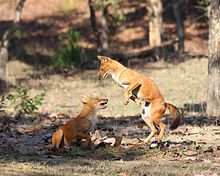
Dholes are more social thangray wolves,[6]and have less of a dominance hierarchy, as seasonal scarcity of food is not a serious concern for them. In this manner, they closely resemble African wild dogs in social structure.[8]They live inclansrather thanpacks,as the latter term refers to a group of animals that always hunt together. In contrast, dhole clans frequently break into small packs of three to five animals, particularly during the spring season, as this is the optimal number for catching fawns.[94]Dominant dholes are hard to identify, as they do not engage in dominance displays as wolves do, though other clan members will show submissive behaviour toward them.[9]Intragroup fighting is rarely observed.[95]
Dholes are far lessterritorialthan wolves, with pups from one clan often joining another without trouble once they mature sexually.[96]Clans typically number 5 to 12 individuals in India, though clans of 40 have been reported. InThailand,clans rarely exceed three individuals.[10]Unlike other canids, there is no evidence of dholes usingurineto mark their territories or travel routes. When urinating, dholes, especially males, mayraise one hind legor both to result in a handstand. Handstand urination is also seen inbush dogs(Speothos venaticus).[97]They may defecate in conspicuous places, though a territorial function is unlikely, asfaecesare mostly deposited within the clan's territory rather than the periphery. Faeces are often deposited in what appear to be communallatrines.They do not scrape the earth with their feet, as other canids do, to mark their territories.[93]
Denning[edit]
Four kinds of den have been described; simple earth dens with one entrance (usually remodeledstriped hyenaorporcupinedens); complex cavernous earth dens with more than one entrance; simple cavernous dens excavated under or between rocks; and complex cavernous dens with several other dens in the vicinity, some of which are interconnected. Dens are typically located under dense scrub or on the banks of dry rivers or creeks. The entrance to a dhole den can be almost vertical, with a sharp turn three to four feet down. The tunnel opens into an antechamber, from which extends more than one passage. Some dens may have up to six entrances leading up to thirty metres (100 ft) of interconnecting tunnels. These "cities" may be developed over many generations of dholes, and are shared by the clan females when raising young together.[98]LikeAfrican wild dogsanddingoes,dholes will avoid killing prey close to their dens.[99]
Reproduction and development[edit]

In India, themating seasonoccurs between mid-October and January, while captive dholes in theMoscow Zoobreed mostly in February.[10]Unlike wolf packs, dhole clans may contain more than one breeding female.[9]More than one female dhole may den and rear their litters together in the same den.[95]Duringmating,the female assumes a crouched, cat-like position. There is nocopulatory tiecharacteristic of other canids when the male dismounts. Instead, the pair lie on their sides facing each other in a semicircular formation.[100]Thegestation periodlasts 60–63 days, with litter sizes averaging four to six pups.[10]Their growth rate is much faster than that of wolves, being similar in rate to that ofcoyotes.
Thehormonemetabolites of five males and three females kept in Thai zoos was studied. The breeding males showed an increased level oftestosteronefrom October to January. Theoestrogenlevel of captive females increases for about two weeks in January, followed by an increase ofprogesterone.They displayed sexual behaviours during the oestrogen peak of the females.[101]
Pups are suckled at least 58 days. During this time, the pack feeds the mother at the den site. Dholes do not userendezvoussites to meet their pups as wolves do, though one or more adults will stay with the pups at the den while the rest of the pack hunts. Onceweaningbegins, the adults of the clan will regurgitate food for the pups until they are old enough to join in hunting. They remain at the den site for 70–80 days. By the age of six months, pups accompany the adults on hunts and will assist in killing large prey such assambarby the age of eight months.[99]Maximum longevity in captivity is 15–16 years.[95]
Hunting behaviour[edit]
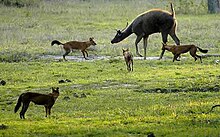
Before embarking on a hunt, clans go through elaborate prehunt social rituals involving nuzzling, body rubbing and mounting.[102]Dholes are primarilydiurnalhunters, hunting in the early hours of the morning. They rarely hunt at night, except on moonlit nights, indicating they greatly rely onsightwhen hunting.[103]They can chase their prey for many hours.[6]During a pursuit, one or more dholes takes over chasing the prey, while the rest of the pack keeps up at a steadier pace behind, taking over once the other group tires. Most chases are short, lasting only 500 m (1,600 ft).[104]When chasing fleet-footed prey, they run at a pace of 50 km/h (30 mph).[6]Dholes frequently drive their prey into water bodies, where the targeted animal's movements are hindered.[105]
Once large prey is caught, one dhole grabs the prey's nose, while the rest of the pack pulls the animal down by the flanks and hindquarters. They do not use a killing bite to the throat.[106]They occasionally blind their prey by attacking the eyes.[107]Serowsare among the only ungulate species capable of effectively defending themselves against dhole attacks, due to their thick, protective coats and short, sharp horns capable of easily impaling dholes.[17]Dholes tear open their prey's flanks anddisembowelit, eating theheart,liver,lungsand some sections of theintestines.Thestomachandrumenare usually left untouched.[108]Prey weighing less than 50 kg (110 lb) is usually killed within two minutes, while large stags may take 15 minutes to die. Once prey is secured, dholes tear off pieces of the carcass and eat in seclusion.[109]They give the pups access to a kill.[9]They are generally tolerant ofscavengersat their kills.[110]Both mother and young are provided with regurgitated food by other pack members.[95]
Feeding ecology[edit]

Prey animals in India includechital,sambar deer,muntjac,mouse deer,barasingha,wild boar,gaur,water buffaloes,banteng,cattle,nilgai,goats,Indian hares,Himalayan field ratsandlangurs.[10][47][111]There is one record of a pack bringing down anIndian elephantcalf inAssam,despite desperate defense of the mother, resulting in numerous losses to the pack.[20]In Kashmir, they prey onmarkhor,[47]andthaminin Myanmar,[10]Malayan tapir,Sumatran serowinSumatraand theMalay PeninsulaandJavan rusain Java.[11]In theTian ShanandTarbagatai Mountains,dholes prey onSiberian ibexes,arkhar,roe deer,Caspian red deerandwild boar.In theAltaiandSayan Mountains,they prey onmusk deerandreindeer.In eastern Siberia, they prey on roe deer,Manchurian wapiti,wild pig, musk deer and reindeer, while inPrimoryethey feed onsika deerandgoral.In Mongolia, they prey onargaliand rarely Siberian ibex.[6]
Like African wild dogs, but unlike wolves, dholes are not known to actively hunt people.[6][47]They are known to eatinsectsandlizards.[112]Dholes eatfruitandvegetablematter more readily than other canids. In captivity, they eat various kinds of grasses, herbs and leaves, seemingly for pleasure rather than just when ill.[113]In summertime in the Tian Shan Mountains, dholes eat large quantities of mountainrhubarb.[6]Although opportunistic, dholes have a seeming aversion to hunting cattle and their calves.[114]Livestockpredation by dholes has been a problem in Bhutan since the late 1990s, as domestic animals are often left outside to graze in the forest, sometimes for weeks at a time. Livestock stall-fed at night and grazed near homes are never attacked.Oxenare killed more often thancows,probably because they are given less protection.[115]
Enemies and competitors[edit]
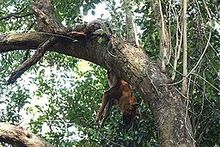
In some areas, dholes aresympatrictotigersandleopards.Competition between these species is mostly avoided through differences in prey selection, although there is still substantial dietary overlap. Along with leopards, dholes typically target animals in the 30–175 kg (66–386 lb) range (mean weights of 35.3 kg [78 lb] for dhole and 23.4 kg [52 lb] for leopard), while tigers selected for prey animals heavier than 176 kg (388 lb) (but their mean prey weight was 65.5 kg [144 lb]). Also, other characteristics of the prey, such as sex, arboreality and aggressiveness, may play a role in prey selection. For example, dholes preferentially select male chital, whereas leopards kill both sexes more evenly (and tigers prefer larger prey altogether), dholes and tigers kill langurs rarely compared to leopards due to the leopards' greater arboreality, while leopards kill wild boar infrequently due to the inability of this relatively light predator to tackle aggressive prey of comparable weight.[12]
Tigers are dangerous opponents for dholes, as they have sufficient strength to kill a dhole with a single paw strike.[20]Dhole packs are smaller in areas with higher tiger densities due to tigers directly killing dholes and stealing kills they made. The kleptoparasitism causes dholes to prefer hunting smaller animals because they can eat more of a smaller carcass before a tiger arrives to steal it. Direct predation can lead to lower reproductive and recruitment rates, lower hunting success rates and less food for the pups when a helper is killed, and potentially pack destabilization if one member of the breeding pair is killed.[116]
Dhole packs may steal leopard kills, while leopards may kill dholes if they encounter them singly or in pairs.[47]There are numerous records of leopards being treed by dholes.[95]Dholes were once thought to be a major factor in reducingAsiatic cheetahpopulations, though this is doubtful, as cheetahs live in open areas as opposed to forested areas favoured by dholes.[117]Since leopards are smaller than tigers and are more likely to hunt dholes, dhole packs tend to react more aggressively toward them than they do towards tigers.[118]
Dhole packs occasionally attackAsiatic black bears,snow leopardsandsloth bears.When attacking bears, dholes will attempt to prevent them from seeking refuge in caves and lacerate their hindquarters.[47] Although usually antagonistic towardwolves,[6]they may hunt and feed alongside one another.[119]
The dhole is also sympatric with theIndian wolf(Canis lupus pallipes) in parts of its range.[120][121]There is at least one record of a lone wolf associating with a pair of dholes inDebrigarh Wildlife Sanctuary,[122]and two observations inSatpura Tiger Reserve.[123]They infrequently associate in mixed groups withgolden jackals.Domestic dogs may kill dholes, though they will feed alongside them on occasion.[124]
Diseases and parasites[edit]
Dholes are vulnerable to a number of different diseases, particularly in areas where they aresympatricwith other canid species. Infectious pathogens such asToxocara canisare present in their faeces. They may suffer fromrabies,canine distemper,mange,trypanosomiasis,canine parvovirusandendoparasitessuch ascestodesandroundworms.[11]
Threats[edit]
Habitat lossis thought to amount to 60% of the dhole's historical range in India. The fragmentation and isolation of dhole populations has resulted in inbreeding and theAllee effect,which threaten its long term viability.[125]
Some ethnic groups like theKurubaandMon Khmer-speaking tribes will appropriate dhole kills; some Indian villagers welcome the dhole because of this appropriation of dhole kills.[95]Dholes were persecuted throughout India for bounties until they were given protection by theWildlife Protection Act of 1972.Methods used for dhole hunting included poisoning, snaring, shooting and clubbing at den sites. Native Indian people killed dholes primarily to protect livestock, while British sporthunters during theBritish Rajdid so under the conviction that dholes were responsible for drops ingamepopulations. Persecution of dholes still occurs with varying degrees of intensity according to the region.[11]Bounties paid for dholes used to be 25rupees,though this was reduced to 20 in 1926 after the number of presented dhole carcasses became too numerous to maintain the established reward.[126]The Indochinese dhole population suffers heavily from nonselective hunting techniques such assnaring.[11] Thefur tradedoes not pose a significant threat to the dhole.[11]The people of India do not eat dhole flesh and their fur is not considered overly valuable.[113]Due to their rarity, dholes were never harvested for their skins in large numbers in theSoviet Unionand were sometimes accepted as dog or wolf pelts (being labeled as "half wolf" for the latter). The winter fur was prized by the Chinese, who bought dhole pelts inUssuriyskduring the late 1860s for a few silverrubles.In the early 20th century, dhole pelts reached eight rubles inManchuria.InSemirechye,fur coatsmade from dhole skin were considered the warmest, but were very costly.[6]
Conservation[edit]
In India, the dhole is protected under Schedule 2 of theWildlife Protection Act, 1972.The creation of reserves underProject Tigerprovided some protection for dhole populations sympatric with tigers. In 2014, the Indian government sanctioned its first dhole conservation breeding centre at theIndira Gandhi Zoological Park(IGZP) inVisakhapatnam.[127]The dhole has been protected in Russia since 1974, though it is vulnerable to poison left out for wolves. In China, the animal is listed as a category II protected species under the Chinese wildlife protection act of 1988. InCambodia,the dhole is protected from all hunting, while conservation laws in Vietnam limit extraction and utilisation.[1]
In 2016, the Korean company Sooam Biotech was reported to be attempting to clone the dhole using dogs assurrogate mothersto help conserve the species.[128]
In culture and literature[edit]

Three dhole-like animals are featured on thecopingstone of theBharhutstupadating from 100 BC. They are shown waiting by a tree, with a woman or spirit trapped up it, a scene reminiscent of dholestreeingtigers.[129]The animal's fearsome reputation in India is reflected by the number of pejorative names it possesses inHindi,which variously translate as "red devil", "devil dog", "jungle devil", or "hound ofKali".[20]
Leopold von Schrenckhad trouble obtaining dhole specimens during his exploration ofAmurland,as the localGilyaksgreatly feared the species. This fear and superstition was not, however, shared by neighbouringTungusic peoples.It was speculated that this differing attitude towards the dhole was due to the Tungusic people's more nomadic, hunter-gatherer lifestyle.[21]
Dholes appear inRudyard Kipling'sRed Dog,where they are portrayed as aggressive and bloodthirsty animals which descend from theDeccan Plateauinto theSeeonee Hillsinhabited byMowgliand his adopted wolf pack to cause carnage among the jungle's denizens. They are described as living in packs numbering hundreds of individuals, and that evenShere KhanandHathimake way for them when they descend into the jungle. The dholes are despised by the wolves because of their destructiveness, their habit of not living in dens and the hair between their toes. With Mowgli andKaa's help, the Seeonee wolf pack manages to wipe out the dholes by leading them through bee hives and torrential waters before finishing off the rest in battle.
Japanese author Uchida Roan wroteKhuyển vật ngữ(Inu monogatari;A dog's tale) in 1901 as anationalisticcritique of the declining popularity of indigenous dog breeds, which he asserted were descended from the dhole.[130]
A fictional version of the dhole, imbued with supernatural abilities, appears in the season 6 episode of TV seriesThe X-Files,titled "Alpha".
In China, the dhole were widely known throughout history and mythology. One notable legendary creature is theYazi(Nhai Tí), which was believed to be a creature that was part-dhole part-dragon. In modern times, however, the Chinese word for dhole (Sài;Chái) is often confused with 'jackal' or 'wolf', resulting in many confusions and mistranslations of dholes as jackals or wolves.[131]
Dholes also appear as enemies in thevideo gameFar Cry 4,alongside other predators such as theBengal tiger,honey badger,snow leopard,clouded leopard,Tibetan wolfandAsian black bear.They can be found hunting the player and otherNPCsacross the map, but are easily killed, being one of the weakest enemies in the game. They once again appear in the video gameFar Cry Primal,where they play similar roles as their counterparts in the previous game, but can now also be tamed and used in combat by Takkar, the main protagonist of the game.
Tameability[edit]
Brian Houghton Hodgsonkept captured dholes in captivity, and found, with the exception of one animal, they remained shy and vicious even after 10 months.[113][132]According toRichard Lydekker,adult dholes are nearly impossible to tame, though pups are docile and can even be allowed to play with domestic dog pups until they reach early adulthood.[17]A dhole may have been presented as a gift to the Akkadian KingIbbi-Sinas tribute referred to in the inscription as the "red dog of Meluhha" or Indus Valley Civilization ofPakistansuggesting a once greater range of the Dhole.[133]
See also[edit]
Notes[edit]
- ^For a full set of supporting references refer to the note (a) in the phylotree atEvolution of the wolf#Wolf-like canids
References[edit]
- ^abcdefghijkKamler, J.F.; Songsasen, N.; Jenks, K.; Srivathsa, A.; Sheng, L.; Kunkel, K. (2015)."Cuon alpinus".IUCN Red List of Threatened Species.2015:e.T5953A72477893.doi:10.2305/IUCN.UK.2015-4.RLTS.T5953A72477893.en.Retrieved24 January2022.
- ^""dhole"".Merriam-Webster.Archivedfrom the original on 7 January 2024.Retrieved7 January2024.
- ^""dhole"".Collins Dictionary.Archivedfrom the original on 1 May 2021.Retrieved7 January2024.
- ^abLindblad-Toh, K.; Wade, C.M.; Mikkelsen, T.S.; Karlsson, E.K.; Jaffe, D.B.; Kamal, M.; Clamp, M.; Chang, J.L.; Kulbokas, E.J.; Zody, M.C.; Mauceli, E.; Xie, X.; Breen, M.; Wayne, R.K.; Ostrander, E.A.; Ponting, C.P.; Galibert, F.; Smith, D.R.; Dejong, P.J.; Kirkness, E.; Alvarez, P.; Biagi, T.; Brockman, W.; Butler, J.; Chin, C.W.; Cook, A.; Cuff, J.; Daly, M.J.; Decaprio, D.; et al. (2005)."Genome sequence, comparative analysis, and haplotype structure of the domestic dog".Nature.438(7069): 803–819.Bibcode:2005Natur.438..803L.doi:10.1038/nature04338.PMID16341006.
- ^abClutton-Brock, J.; Corbet, G. G. & Hills, M. (1976)."A review of the family Canidae, with a classification by numerical methods".Bulletin of the British Museum of Natural History.29:179–180. Archived fromthe originalon 17 December 2013.Retrieved8 December2014.
- ^abcdefghijklmnopqrsHeptner, V. G.; Naumov, N. P., eds. (1998)."GenusCuonHodgson, 1838 ".Mammals of the Soviet Union.Vol. (II. Part 1A: Sirenia and Carnivora (Sea Cows, Wolves, and Bears)). Washington, DC: Smithsonian Institution and National science Foundation. pp. 566–586.ISBN1-886106-81-9.
- ^Zhang, H.; Chen, L. (2010). "The complete mitochondrial genome of dholeCuon alpinus:Phylogenetic analysis and dating evolutionary divergence within canidae ".Molecular Biology Reports.38(3): 1651–1660.doi:10.1007/s11033-010-0276-y.PMID20859694.S2CID7476436.
- ^abFox 1984,p. 85
- ^abcdFox 1984,pp. 86–87
- ^abcdefghiCohen, James A. (1978)."Cuon alpinus".Mammalian Species(100): 1–3.doi:10.2307/3503800.JSTOR3503800.
- ^abcdefghijklmnopqrstuvDurbin, D.L.; Venkataraman, A.; Hedges, S. & Duckworth, W. (2004)."8.1–Dhole"(PDF).In Sillero-Zubiri, C.; Hoffmann, M. & Macdonald, D.W. (eds.).Canids: Foxes, Wolves, Jackals, and Dogs:Status Survey and Conservation Action Plan.IUCN The World Conservation Union. p. 211.ISBN978-2831707860.Archived(PDF)from the original on 13 October 2006.Retrieved31 January2020.
- ^abKaranth, K. U. & Sunquist, M. E. (1995). "Prey selection by tiger, leopard and dhole in tropical forests".Journal of Animal Ecology.64(4): 439–450.Bibcode:1995JAnEc..64..439K.doi:10.2307/5647.JSTOR5647.
- ^Williamson, T. (1808).Oriental field sports: being a complete, detailed, and accurate description of the wild sports of the East.Vol. II. London: Orme.
- ^Smith, C. H. (1827).The class Mammalia.London: Geo. B. Whittaker.
- ^Smith, C. H.; Jardine, W. (1839).The natural history of dogs: Canidae or genus canis of authors; including also the genera hyaena and proteles.Vol. I. Edinburgh, UK: W.H. Lizars.
- ^Orel, V.(2003),A Handbook of Germanic Etymology,Leiden, DE; Boston, MA: Brill, p.81,ISBN978-90-04-12875-0
- ^abcdLydekker, R. (1907).The game animals of India, Burma, Malaya, and Tibet.London, UK: R. Ward Limited.
- ^dholeArchived24 December 2016 at theWayback Machine.Merriam-Webster Dictionary.
- ^Fox 1984
- ^abcdPerry, R. (1964).The World of the Tiger.London: Cassell.
- ^abSchrenk, L. v.(1859)."Canis alpinus".Reisen und Forschungen im Amur-lande in den jahren 1854–1856(in German). St. Petersburg: Kaiserliche Akademie der Wissenschaften. pp. 48–50.
- ^abPallas, P. S. (1811)."Canis alpinus".Zoographia Rosso-Asiatica: Sistens omnium animalium in extenso Imperio Rossico, et adjacentibus maribus observatorum recensionem, domicilia, mores et descriptiones, anatomen atque icones plurimorum(in Latin). Petropoli: In officina Caes. Acadamiae Scientiarum Impress. pp. 34–35.
- ^abHeptner, V. G.; Naumov, N. P., eds. (1998)."Red WolfCuon alpinusPallas, 1811 ".Mammals of the Soviet Union.Vol. II. Washington, DC: Smithsonian Institution and National Science Foundation. Part 1A: Sirenia and Carnivora (Sea Cows, Wolves, and Bears), pp. 571–586.
- ^Hodgson, B. H. (1833)."Description and Characters of the Wild Dog of the Himalaya (Canis primævus) ".Asiatic Researches.XVIII(2): 221–237, 235.
- ^Hodgson, B. H. (1842)."European notices of Indian canines, with further illustrations of the new genusCuonvelChrysæus".Calcutta Journal of Natural History.II:205–209.
- ^abThenius, E. (1955)."Zur Abstammung der Rotwölfe (GattungCuonHodgson) "[On the origins of the dholes (GenusCuonHodgson)](PDF).Österreichische Zoologische Zeitschrift(in German).5:377–388.Archived(PDF)from the original on 10 November 2014.
- ^Kurtén, B.(1968).Pleistocene mammals of Europe.Weidenfeld and Nicolson. pp. 111–114.ISBN9781412845144.
- ^Ripoll, M.P.R.; Morales Pérez, J.V.; Sanchis Serra, A.; et al. (2010). "Presence of the genusCuonin upper Pleistocene and initial Holocene sites of the Iberian Peninsula: New remains identified in archaeological contexts of the Mediterranean region ".Journal of Archaeological Science.37(3): 437–450.Bibcode:2010JArSc..37..437R.doi:10.1016/j.jas.2009.10.008.
- ^Petrucci, M.; Romiti, S. & Sardella, R. (2012)."The Middle-Late PleistoceneCuonHodgson, 1838 (Carnivora, Canidae) from Italy "(PDF).Bollettino della Società Paleontologica Italiana.51(2): 146.Archived(PDF)from the original on 2 January 2015.
- ^abTaron, U.H.; Paijmans, J.L.A.; Barlow, A.; et al. (2021)."Ancient DNA from the Asiatic Wild Dog (Cuon alpinus) from Europe ".Genes.12(2): 144.doi:10.3390/genes12020144.PMC7911384.PMID33499169.
- ^Nowak, R. M. (2005)."Cuon".Walker's Carnivores of the World.Baltimore, Maryland: Johns Hopkins University Press. pp. 110–111.ISBN9780801880322.
- ^Cranbrook, E. (1988)."The contribution of archaeology to the zoogeography of Borneo: with the first record of a wild canid of Early Holocene Age; a contribution in celebration of the distinguished scholarship of Robert F. Inger on the occasion of his sixty-fifth birthday".Fieldiana Zoology.42: 6–24.
- ^Ochoa, J.; Paz, V.; Lewis, H.; et al. (2014). "The archaeology and palaeobiological record of Pasimbahan-Magsanib Site, northern Palawan, Philippines".Philippine Science Letters.7(1): 22–36.hdl:10197/5394.ISSN2094-2818.S2CID55862985.
- ^Dennell, R.; Parr, M. (2014).Southern Asia, Australia, and the Search for Human Origins.New York: Cambridge University Press. p. 139.ISBN9781107729131.Archivedfrom the original on 15 April 2021.Retrieved29 July2016.
- ^Tarling, N. (1992).The Cambridge History of Southeast Asia.Vol. (Volume One: From Early Times to ca. 1800). Cambridge, UK: Cambridge University Press. p. 84.ISBN978-0-5213-5505-6.Archivedfrom the original on 3 February 2021.Retrieved30 August2015.
- ^Piper, P.J.; Ochoa, J.B.; Robles, E.C.; et al. (2011)."Palaeozoology of Palawan Island, Philippines".Quaternary International.233(2): 142–158.Bibcode:2011QuInt.233..142P.doi:10.1016/j.quaint.2010.07.009.Archivedfrom the original on 3 March 2024.Retrieved29 July2021.
- ^Ogino, S.; Otsuka, H.; Harunari, H. (December 2009). "The Middle Pleistocene Matsugae Fauna, Northern Kyushu, West Japan".Paleontological Research.13(4): 367–384.doi:10.2517/1342-8144-13.4.367.S2CID53691225.
- ^abTurvey, S.T.; Walsh, C.; Hansford, J.P.; et al. (2019)."Complementarity, completeness and quality of long-term faunal archives in an Asian biodiversity hotspot".Philosophical Transactions of the Royal Society B: Biological Sciences.374(1788): 20190217.doi:10.1098/rstb.2019.0217.PMC6863502.PMID31679488.
- ^"Nghi sài, lang hoá thạch đại giáp khê giường hiện tung"[Suspected dhole and wolf fossils found in the bed of Dajia River].Taiwan Geoscience Portal(in Chinese). October 2009. Archived fromthe originalon 22 April 2023.Retrieved1 September2022.
- ^Tedford, Richard H.; Wang, Xiaoming; Taylor, Beryl E. (3 September 2009)."Phylogenetic Systematics of the North American Fossil Caninae (Carnivora: Canidae)".Bulletin of the American Museum of Natural History.325:1–218.doi:10.1206/574.1.ISSN0003-0090.
- ^Ripoll, Manuel Pérez; Morales Pérez, Juan V.; Sanchis Serra, Alfred; Aura Tortosa, J. Emili; Montañana, Inocencio Sarrión (1 March 2010)."Presence of the genus Cuon in upper Pleistocene and initial Holocene sites of the Iberian Peninsula: new remains identified in archaeological contexts of the Mediterranean region".Journal of Archaeological Science.37(3): 437–450.Bibcode:2010JArSc..37..437R.doi:10.1016/j.jas.2009.10.008.ISSN0305-4403.Archivedfrom the original on 24 September 2015.Retrieved16 January2024– via Elsevier Science Direct.
- ^Simpson, G. G. (1945). "The principles of classification and a classification of mammals".Bulletin of the American Museum of Natural History.85:1–350.hdl:2246/1104.
- ^Moulle, P.E.; Echassoux, A.; Lacombat, F. (2006)."Taxonomie du grand canidé de la grotte du Vallonnet (Roquebrune-Cap-Martin, Alpes-Maritimes, France)".L'Anthropologie.110(5): 832–836.doi:10.1016/j.anthro.2006.10.001.Archived fromthe originalon 14 March 2012.Retrieved30 July2017.(in French)
- ^Baryshnikov, G.F. (2012)."Pleistocene Canidae (Mammalia, Carnivora) from the Paleolithic Kudaro caves in the Caucasus".Russian Journal of Theriology.11(2): 77–120.doi:10.15298/rusjtheriol.11.2.01.
- ^Cherin, M.; Bertè, D.F.; Rook, L.; Sardella, R. (2013). "Re-DefiningCanis etruscus(Canidae, Mammalia): A New Look into the evolutionary history of Early Pleistocene dogs resulting from the outstanding fossil record from Pantalla (Italy) ".Journal of Mammalian Evolution.21:95–110.doi:10.1007/s10914-013-9227-4.S2CID17083040.
- ^Wang, X.; Tedford, R.H. (2008).Dogs: Their Fossil Relatives and Evolutionary History.New York: Columbia University Press.doi:10.7312/wang13528.ISBN9780231509435.
- ^abcdefghPocock, R. I.(1941)."GenusCuonHodgs. ".Fauna of British India: Mammals.Vol. 2. Taylor & Francis. pp. 146–163.
- ^abCiucani, Marta Maria; Jensen, Julie Kragmose; Sinding, Mikkel-Holger S.; Smith, Oliver; Lucenti, Saverio Bartolini; Rosengren, Erika; Rook, Lorenzo; Tuveri, Caterinella; Arca, Marisa; Cappellini, Enrico; Galaverni, Marco; Randi, Ettore; Guo, Chunxue; Zhang, Guojie; Sicheritz-Pontén, Thomas (December 2021)."Evolutionary history of the extinct Sardinian dhole".Current Biology.31(24): 5571–5579.e6.Bibcode:2021CBio...31E5571C.doi:10.1016/j.cub.2021.09.059.hdl:2158/1252046.PMID34655517.S2CID238996621.
- ^Gopalakrishnan, S.; Sinding, M.-H.S.; Ramos-Madrigal, J.; et al. (2018)."Interspecific gene flow shaped the evolution of the GenusCanis".Current Biology.28(21): 3441–3449.e5.Bibcode:2018CBio...28E3441G.doi:10.1016/j.cub.2018.08.041.PMC6224481.PMID30344120.
- ^Ellerman, J.R.; Morrison-Scott, T.C.S. (1966).Checklist of Palaearctic and Indian mammals.London, UK: British Museum (Natural History).
- ^Wozencraft, C. W. (2005)."Order Carnivora".In Wilson, D. E.; Reader, D. M. (eds.).Mammal Species of the World: A Taxonomic and Geographic Reference.Vol. 1 (3rd ed.). Johns Hopkins University Press. p. 578.ISBN978-0-8018-8221-0.Archivedfrom the original on 3 March 2024.Retrieved3 March2024.
- ^Orrell T (2020). Nicolson D, Roskov Y, Abucay L, Orrell T, Nicolson D, Bailly N, Kirk PM, Bourgoin T, DeWalt RE, Decock W, De Wever A, van Nieukerken E, Zarucchi J, Penev L (eds.)."Cuon alpinus (Pallas, 1811) (accepted name)".Catalogue of Life: 2019 Annual Checklist.Catalogue of Life.Archivedfrom the original on 6 February 2020.Retrieved5 February2020.
- ^"Dhole | Canids".canids.org.Archivedfrom the original on 23 September 2021.
- ^Iyengar, A.; Babu, V. N.; Hedges, S.; et al. (2005)."Phylogeography, genetic structure, and diversity in the dhole (Cuon alpinus) "(PDF).Molecular Ecology.14(8): 2281–2297.Bibcode:2005MolEc..14.2281I.doi:10.1111/j.1365-294X.2005.02582.x.PMID15969714.S2CID8280811.Archived(PDF)from the original on 7 March 2020.
- ^Volmer, R.; van der Geer, A.A.E.; Cabrera, P.A.; et al. (September 2019)."When did Cuon reach Java? – Reinvestigation of canid fossils from Homo erectus faunas".Geobios.55:89–102.Bibcode:2019Geobi..55...89V.doi:10.1016/j.geobios.2019.06.004.
- ^abcdePocock, R.I. (1936). "The Asiatic Wild Dog or Dhole (Cuon javanicus) ".Proceedings of the Zoological Society of London.106:33–55.doi:10.1111/j.1096-3642.1936.tb02278.x.
- ^Афанасьев, А.В.; Золотарев, Н.Т. (1935)."Новые данные по систематике и распространению красного волка"[Contribution to the systematics and distribution of red wolf].Известия Академии наук СССР.VII Отделение математических и естественных наук (in Russian) (3): 425–429.Archivedfrom the original on 3 March 2024.Retrieved27 July2021.
- ^Heude, Mém. Hist. Nat. Empire Chinois, II, pt2, p. 102 footnote 1892
- ^Castelló, J.R. (2018)."Ch.2 - Wolf-like Canids".Canids of the World: Wolves, Wild Dogs, Foxes, Jackals, Coyotes, and Their Relatives.Princeton University Press.p. 155.ISBN978-0-691-18372-5.Archivedfrom the original on 14 June 2021.Retrieved14 June2021.
- ^Hardwicke, T. (1821)."Descriptions of the Wild Dog of Sumatra, a new Species of Viverra, and a new Species of Pheasant".Transactions of the Linnean Society of London.3:235–238.Archivedfrom the original on 23 October 2023.Retrieved3 March2024.
- ^Mahabal, A.; Sharma, R.M.; Patil, R.N. & Jadhav, S. (2019)."Colour aberration in Indian mammals: a review from 1886 to 2017".Journal of Threatened Taxa.11(6): 13690–13719.doi:10.11609/jott.3843.11.6.13690-13719.
- ^Fox 1984,pp. 61–2
- ^Fox 1984,pp. 41
- ^Kamler J. F.; Johnson A.; Vongkhamheng C. & Bousa A. (2012). "The diet, prey selection, and activity of dholes (Cuon alpinus) in northern Laos ".Journal of Mammalogy.93(3): 627–633.doi:10.1644/11-mamm-a-241.1.S2CID54996917.
- ^abCancellare, I.A.; Kachel, S.M.; Kubanychbekov, Z.; Kulenbekov, R.; Pilgrim, K.L.; McCarthy, K.P. & Weckworth, B.V. (2022)."New distribution record of dhole from southern Kyrgyzstan using non-invasive genetic sampling"(PDF).Canid Biology & Conservation.24(1): 1–3.Archived(PDF)from the original on 2 February 2022.Retrieved22 February2022.
- ^Williams, M. & Troitskaya, N. (2007)."Then and Now: Updates from Russia's Imperiled Zapovedniks"(PDF).Russian Conservation News.42:14.Archived(PDF)from the original on 28 January 2012.
- ^Newell, J. (2004).The Russian Far East: A Reference Guide for Conservation and Development(Second ed.). McKinleyville: Daniel & Daniel.
- ^abMakenov, M. (2018). "Extinct or extant? A review of dhole (Cuon alpinusPallas, 1811) distribution in the former USSR and modern Russia ".Mammal Research.63(1): 1–9.doi:10.1007/s13364-017-0339-8.S2CID20037994.
- ^Harris, R. B. (2006). "Attempted predation on blue sheepPseudois nayaurby dholesCuon alpinus".Journal of the Bombay Natural History Society.103:95–97.
- ^Riordan, P. (2015)."New evidence of dholeCuon alpinuspopulations in northwest China ".Oryx.49(2): 203–204.doi:10.1017/s0030605315000046.Archivedfrom the original on 3 March 2024.Retrieved19 December2017.
- ^Yadong, X.; Diqiang, L.; Wenfa, X.; Yuguang, Z.; Bin, F.; Heng, J. (2015). "Records of the dhole (Cuon alpinus) in an arid region of the Altun Mountains in western China ".European Journal of Wildlife Research.61(6): 903–907.doi:10.1007/s10344-015-0947-z.S2CID16752357.
- ^Li, X.; Buzzard, P.; Chen, Y. & Jiang, X. (2013). "Patterns of livestock predation by carnivores: human-wildlife conflict in northwest Yunnan, China".Environ Manage.52(6): 1334–1340.Bibcode:2013EnMan..52.1334L.doi:10.1007/s00267-013-0192-8.PMID24202281.S2CID5273403.
- ^Canid and Hyaenid Taxon Advisory Group (2017).Best Practice Guideline Dhole (C. alpinus)(PDF).Amsterdam: European Association of Zoos and Aquaria.Archived(PDF)from the original on 6 February 2020.
- ^Kao, J., N. Songsasen, K. Ferraz and K. Traylor-Holzer (Eds.) (2020). Range-wide Population and Habitat Viability Assessment for the Dhole,Cuon alpinus.IUCN SSC Conservation Planning Specialist Group, Apple Valley, MN, USA. p8.https:// canids.org/resources/Dhole_PHVA_Report_2020.pdfArchived6 June 2020 at theWayback Machine
- ^Thapa, K.; Kelly, M. J.; Karki, J. B. & Subedi, N. (2013)."First camera trap record of pack hunting dholes in Chitwan National Park, Nepal"(PDF).Canid Biology & Conservation.16(2): 4–7.Archived(PDF)from the original on 21 December 2014.
- ^Khatiwada, A. P.; Awasthi, K. D.; Gautam, N. P.; Jnawali, S. R.; Subedi, N. & Aryal, A. (2011)."The Pack Hunter (Dhole): Received Little Scientific Attention".The Initiation.4:8–13.doi:10.3126/init.v4i0.5531.Archivedfrom the original on 22 September 2017.Retrieved20 April2018.
- ^Parmar, Vijaysinh (23 May 2020)."Rare whistling dogs spotted in Gujarat after 50 years".The Times of India.Archivedfrom the original on 1 June 2020.Retrieved1 June2020.
- ^Wangchuk, T. (2004)."Predator-prey dynamics: the role of predators in the control of problem species"(PDF).Journal of Bhutan Studies.10:68–89.Archived(PDF)from the original on 24 February 2015.
- ^Thinley, P.; Kamler, J. F.; Wang, S. W.; Lham, K.; Stenkewitz, U. (2011). "Seasonal diet of dholes (Cuon alpinus) in northwestern Bhutan ".Mammalian Biology.76(4): 518–520.doi:10.1016/j.mambio.2011.02.003.
- ^"Tiger country? Scientists uncover wild surprises in tribal Bangladesh".TheGuardian.March 2016.Archivedfrom the original on 29 July 2020.Retrieved6 June2020.
- ^Saw Sha Bwe Moo; Froese, G.Z.L.; Gray, T. N. E. (2017)."First structured camera-trap surveys in Karen State, Myanmar, reveal high diversity of globally threatened mammals".Oryx.52(3): 1–7.doi:10.1017/S0030605316001113.
- ^"Sumatran secrets start to be revealed by high altitude camera trapping".Flora and Fauna International.Archived fromthe originalon 1 May 2017.Retrieved5 September2015.
- ^Jenks, K. E.; Songsasen, N. & P. Leimgruber (2012)."Camera trap records of dholes in Khao Ang Rue Nai Wildlife Sanctuary, Thailand"(PDF).Canid News:1–5.Archived(PDF)from the original on 21 December 2014.
- ^Kamler J. F.; Johnson A.; Chanthavy, V.; Bousa, A. (2012). "The diet, prey selection, and activity of dholes (Cuon alpinus) in northern Laos ".Journal of Mammalogy.93(3): 627–633.doi:10.1644/11-mamm-a-241.1.S2CID54996917.
- ^Rasphone, Akchousanh; Kéry, Marc; Kamler, Jan F.; Macdonald, David W. (October 2019)."Documenting the demise of tiger and leopard, and the status of other carnivores and prey, in Lao PDR's most prized protected area: Nam Et - Phou Louey".Global Ecology and Conservation.20:e00766.doi:10.1016/j.gecco.2019.e00766.S2CID202920288.
- ^Hoffmann, Michael; Abramov, Alexei; Duc, Hoang Minh; Trai, Le Trong; Long, Barney; Nguyen, An; Son, Nguyen Truong; Rawson, Ben; Timmins, Robert; Bang, Tran Van; Willcox, Daniel (26 June 2019)."The status of wild canids (Canidae, Carnivora) in Vietnam".Journal of Threatened Taxa.11(8): 13951–13959.doi:10.11609/jott.4846.11.8.13951-13959.S2CID198272874.
- ^Serez, M. & Eroðlu, M. (1994). "A new threatened wolf species,Cuon alpinus hesperiusAfanasiev and Zolatarev, 1935 in Turkey ".Council of Europe Environmental Encounters Series.17:103–106.
- ^Khatukhov, A.M. (2015)."Красный волк (Cuon alpinusPallas, 1811) на Центральном Кавказе "[The Dhole (Cuon alpinusPallas 1811) in the Central Caucasus](PDF).Современные проблемы науки и образования.3:574–581.Archived(PDF)from the original on 8 December 2015.
- ^"NMNHS expedition went on the trail of an unknown population of the rare dhole in Turkey".National Museum of Natural History, Sofia (NMNHS).2015.Archivedfrom the original on 9 September 2015.Retrieved4 September2015.
- ^Coel, C. (2015)."[UPDATE] Strongly endangered and undescribed subspecies of dhole discovered? Dhole NOT less endangered than previously thought, according to NMNHS (Bulgaria)".Consortium of European Taxonomic Facilities.Archived fromthe originalon 8 December 2015.Retrieved15 October2015.
- ^Fox 1984,p. 93
- ^Fox 1984,p. 95
- ^abFox 1984,p. 97
- ^Fox 1984,pp. 81–2
- ^abcdefWalker, E. P.; Nowak, R. M. & Warnick, F. (1983).Walker's Mammals of the World(Fourth ed.). Baltimore: Johns Hopkins University Press.
- ^Fox 1984,p. 92
- ^Keller, R. (1973)."Einige beobachtungen zum verhalten des Dekkan-Rothundes (Cuon alpinus dukhunensis Sykes) im Kanha National Park"[Some observations on the behavior of the Deccan Red Dog (Cuon alpinus dukhunensis Sykes) in Kanha National Park](PDF).Vierteljahresschrift. Naturf. Ges. Zürich(in German).118:129–135.Archived(PDF)from the original on 12 August 2019.
- ^Fox 1984,pp. 43–49
- ^abFox 1984,p. 80
- ^Fox 1984,p. 79
- ^Khonmee, J.; Rojanasthien, S.; Thitaram, C.; Sumretprasong, J.; Aunsusin, A.; Chaisongkram, C. & Songsasen, N. (2017)."Non-invasive endocrine monitoring indicates seasonal variations in gonadal hormone metabolites in dholes (Cuon alpinus) ".Conservation Physiology.5(1): cox001.doi:10.1093/conphys/cox001.PMC5570072.PMID28852505.
- ^Fox 1984,pp. 100–101
- ^Fox 1984,p. 50
- ^Fox 1984,p. 73
- ^Fox 1984,p. 67
- ^Fox 1984,p. 61
- ^Grassman, L. I. Jr.; M. E. Tewes; N. J. Silvy & K. Kreetiyutanont (2005)."Spatial ecology and diet of the dholeCuon alpinus(Canidae, Carnivora) in north central Thailand ".Mammalia.69(1): 11–20.doi:10.1515/mamm.2005.002.S2CID85198149.Archived fromthe originalon 23 November 2006.
- ^Fox 1984,p. 63
- ^Fox 1984,p. 70
- ^Fox 1984,p. 51
- ^Fox 1984,pp. 58–60
- ^Chacon, Raquel."Cuon alpinus (dhole)".Animal Diversity Web.Archivedfrom the original on 27 January 2023.Retrieved4 April2023.
- ^abcMivart, G. (1890)."GenusCyon,Hodgson (1838) ".Dogs, Jackals, Wolves and Foxes: A Monograph of the Canidæ.London: R.H. Porter. pp. 177–188.
- ^Fox 1984,p. 71
- ^Johnsingh, A.J.T.; Yonten, D.; Wangchuck, S. (2007)."Livestock-Dhole Conflict in Western Bhutan".Journal of the Bombay Natural History Society.104(2): 201–202 – via Biodiversity Heritage Library.
- ^Habib, B.; Nigam P.; Ghaskadbi P. & Bhandari A. (2021)."Dhole pack size variation: Assessing the effect of prey availability and apex predator".Ecology and Evolution.11(9): 4774–4785.Bibcode:2021EcoEv..11.4774B.doi:10.1002/ece3.7380.PMC8093734.PMID33976847.
- ^Finn, F. (1929).Sterndale's Mammalia of India.London: Thacker, Spink & Co.
- ^Venkataraman, A. (1995)."Do dholes (Cuon alpinus) live in packs in response to competition with or predation by large cats? "(PDF).Current Science.69(11): 934–936.Archived(PDF)from the original on 13 July 2019.
- ^Shrestha, T. J. (1997).Mammals of Nepal: (with reference to those of India, Bangladesh, Bhutan and Pakistan).Kathmandu: Bimala Shrestha.ISBN978-0-9524390-6-6.
- ^Mukherjee, S.; Zelcer, M. & Kotler, B.P. (2009). "Patch use in time and space for a meso-predator in a risky world".Oecologia.159(3): 661–668.Bibcode:2009Oecol.159..661M.doi:10.1007/s00442-008-1243-3.PMID19082629.S2CID24051254.
- ^Afik, D.; Pinshow, B. (1993). "Temperature regulation and water economy in desert wolves".Journal of Arid Environments.24(2): 197–209.Bibcode:1993JArEn..24..197A.doi:10.1006/jare.1993.1017.
- ^Nair M. V. & Panda S. K. (2013)."Just Friends".Sanctuary Asia.XXXIII:3. Archived fromthe originalon 24 July 2019.Retrieved23 December2014.
- ^Ghaskadbi, P.; Das, J.; Mahadev, V. & Habib, B. (2021)."First record of mixed species association between dholes and a wolf from Satpura Tiger Reserve, India"(PDF).Canid Biology & Conservation.23(4): 15–17.Archived(PDF)from the original on 17 October 2021.
- ^Humphrey, S. R. & Bain, J. R. (1990).Endangered Animals of Thailand.Gainesville: Sandhill Crane Press.ISBN978-1-877743-07-8.
- ^Modi, S.; Mondol, S.; Nigam, P.; Habib, B. (2021)."Genetic analyses reveal demographic decline and population differentiation in an endangered social carnivore, Asiatic wild dog".Nature.11(1): 16371.Bibcode:2021NatSR..1116371M.doi:10.1038/s41598-021-95918-3.PMC8361113.PMID34385570.
- ^Fox 1984,p. 109
- ^Zoo to have conservation breeding centre for ‘dhole’Archived3 March 2024 at theWayback Machine,The Hindu(18 August 2014)
- ^Zastrow, M. (8 February 2016)."Inside the cloning factory that creates 500 new animals a day".New Scientist.Archivedfrom the original on 22 February 2016.Retrieved23 February2016.
- ^van der Geer, A. A. E. (2008),Animals in stone: Indian mammals sculptured through time,BRILL, p. 188,ISBN90-04-16819-2
- ^Skabelund, A. H. (2011).Empire of Dogs: Canines, Japan, and the Making of the Modern Imperial World.Cornell University Press, p. 85,ISBN0801463246
- ^Schafer, Edward H. (1991)."Brief Note: The Chinese Dhole".Asia Major.4(1): 1–6.ISSN0004-4482.JSTOR41645459.
- ^Hodgson, B.H. (1833)."Description of the Wild Dog of the Himalaya".Asiatic Researches.XVIII:226.Archivedfrom the original on 29 January 2021.Retrieved14 January2021.
- ^McIntosh, J. (2008).The ancient Indus Valley: new perspectives,p. 130, ABC-CLIO,ISBN1-57607-907-4
Bibliography[edit]
- Fox, M.W. (1984).The Whistling Hunters: Field Studies of the Asiatic Wild Dog (Cuon alpinus).Albany: State University of New York Press.ISBN978-0-9524390-6-6.
- Karanth, U.K. (2006).A View From the Machan.Karnataka: Permanent Black.ISBN978-8-1782413-7-1.
External links[edit]
- Dhole Home Page(Archive)
- ARKive –images and movies of the dhole
- Saving the dhole: The forgotten 'badass' Asian dog more endangered than tigers,The Guardian(25 June 2015)
- Photos of dhole in Bandipur
- IUCN Red List endangered species
- Dhole
- Canina (subtribe)
- Taxa named by Peter Simon Pallas
- Mammals described in 1811
- Carnivorans of Asia
- Mammals of South Asia
- Mammals of Southeast Asia
- Endangered fauna of Asia
- Pleistocene mammals of Asia
- Extant Middle Pleistocene first appearances
- Species endangered by habitat fragmentation
- Endangered Fauna of China


